Leadership Styles: Authentic vs. Ethical - A Detailed Comparison
VerifiedAdded on 2022/08/12
|9
|1995
|20
Essay
AI Summary
This essay provides a comprehensive comparison of authentic and ethical leadership models. It begins by defining authentic leadership, emphasizing its focus on leader sincerity, self-awareness, and transparency, along with its impact on employee satisfaction. It outlines the four key components of authentic leadership: self-awareness, rational transparency, balanced processing, and internalized moral perspective, while also exploring both its strengths, such as fostering trust and ethical behavior, and weaknesses, including potential rigidity and challenges in adapting to various situations. The essay then shifts to ethical leadership, defining it as leadership based on moral values, honesty, and justice. It explores ethical leadership's challenges, like adhering to company policies and navigating morally ambiguous situations, and highlights its strengths, such as reducing business liability and creating a positive work environment. The essay concludes by advocating for authentic leadership as a foundational model, recognizing its integration of ethical principles and its ability to foster lasting relationships and promote employee satisfaction. The essay also references several academic sources to support its analysis.
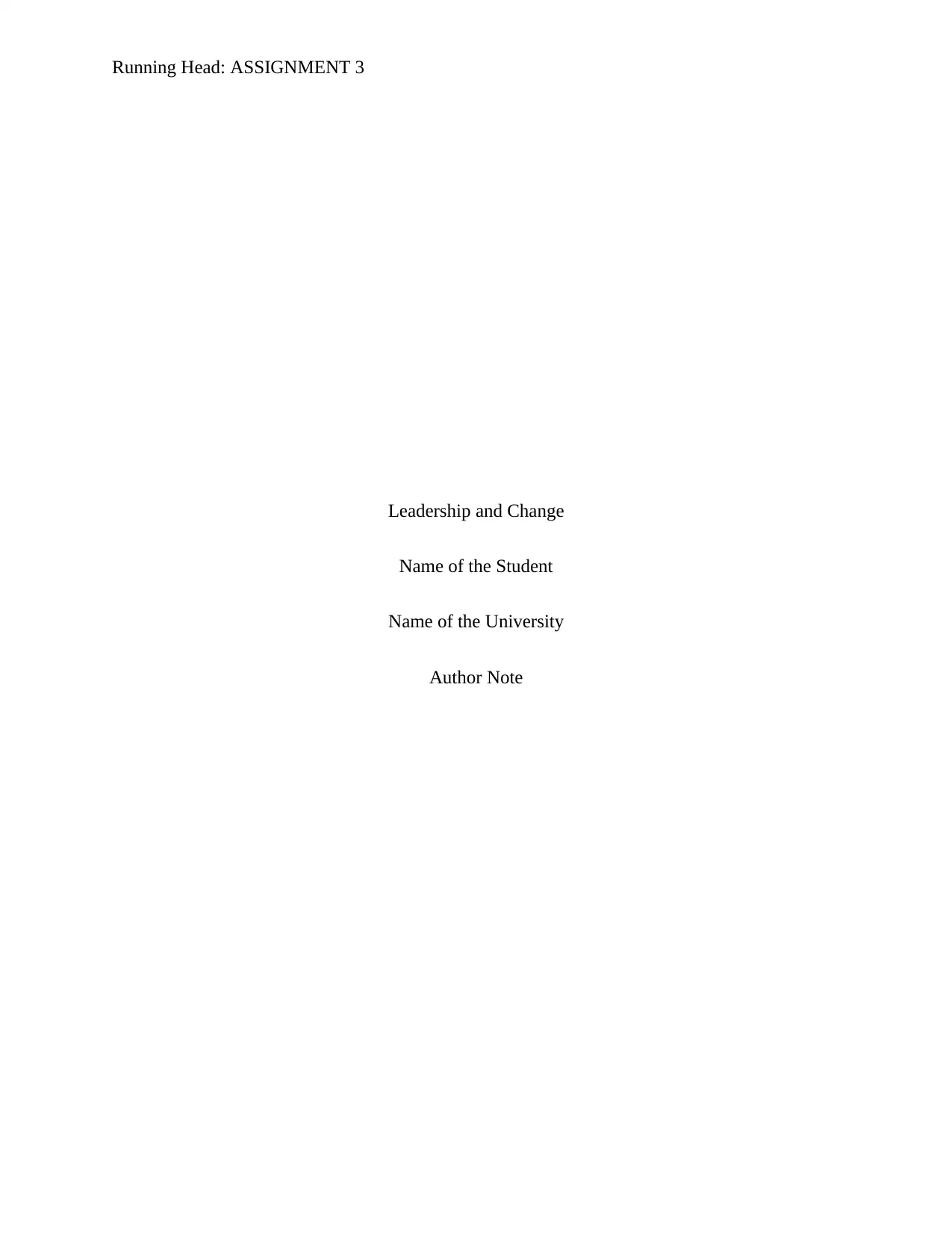
Running Head: ASSIGNMENT 3
Leadership and Change
Name of the Student
Name of the University
Author Note
Leadership and Change
Name of the Student
Name of the University
Author Note
Paraphrase This Document
Need a fresh take? Get an instant paraphrase of this document with our AI Paraphraser
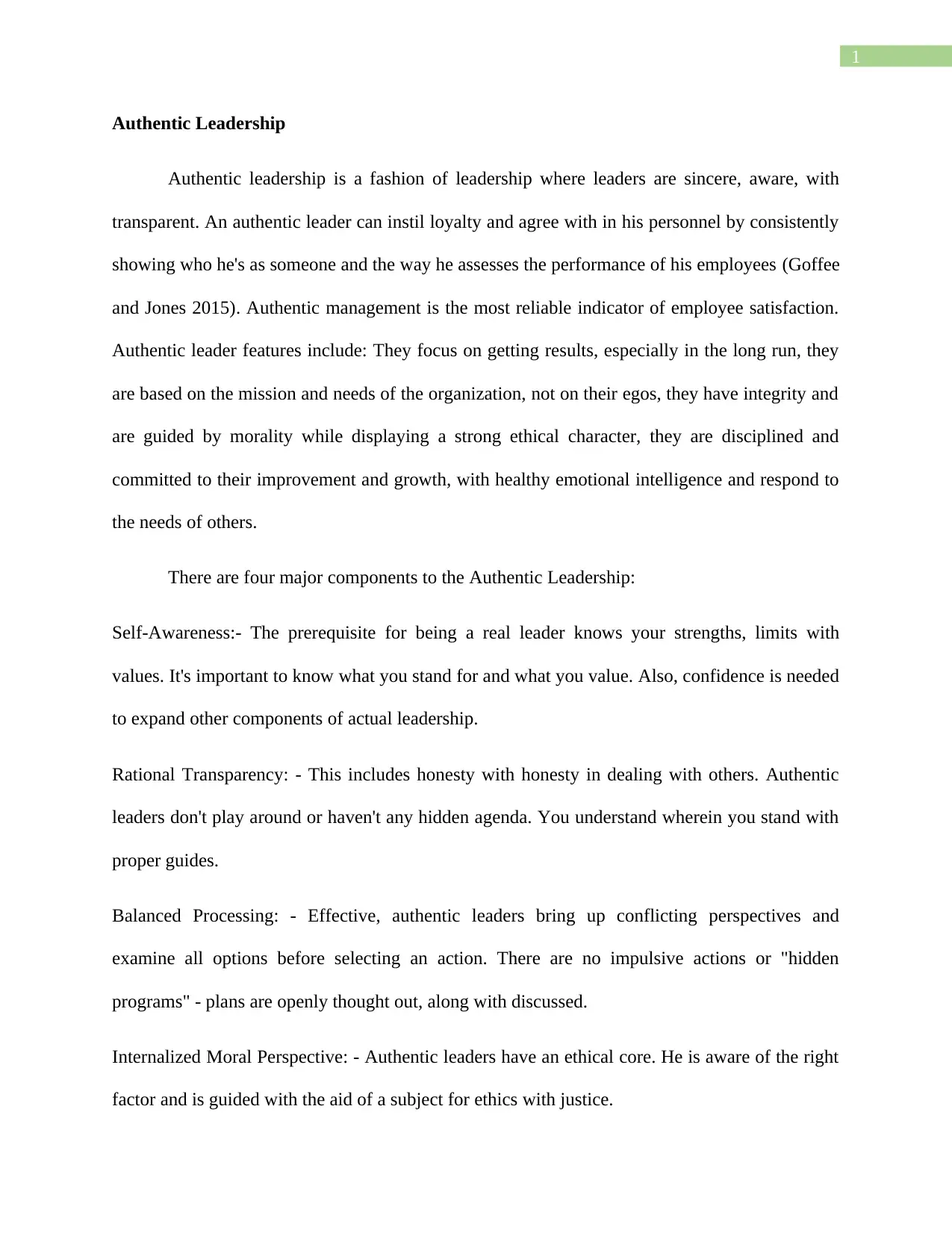
1
Authentic Leadership
Authentic leadership is a fashion of leadership where leaders are sincere, aware, with
transparent. An authentic leader can instil loyalty and agree with in his personnel by consistently
showing who he's as someone and the way he assesses the performance of his employees (Goffee
and Jones 2015). Authentic management is the most reliable indicator of employee satisfaction.
Authentic leader features include: They focus on getting results, especially in the long run, they
are based on the mission and needs of the organization, not on their egos, they have integrity and
are guided by morality while displaying a strong ethical character, they are disciplined and
committed to their improvement and growth, with healthy emotional intelligence and respond to
the needs of others.
There are four major components to the Authentic Leadership:
Self-Awareness:- The prerequisite for being a real leader knows your strengths, limits with
values. It's important to know what you stand for and what you value. Also, confidence is needed
to expand other components of actual leadership.
Rational Transparency: - This includes honesty with honesty in dealing with others. Authentic
leaders don't play around or haven't any hidden agenda. You understand wherein you stand with
proper guides.
Balanced Processing: - Effective, authentic leaders bring up conflicting perspectives and
examine all options before selecting an action. There are no impulsive actions or "hidden
programs" - plans are openly thought out, along with discussed.
Internalized Moral Perspective: - Authentic leaders have an ethical core. He is aware of the right
factor and is guided with the aid of a subject for ethics with justice.
Authentic Leadership
Authentic leadership is a fashion of leadership where leaders are sincere, aware, with
transparent. An authentic leader can instil loyalty and agree with in his personnel by consistently
showing who he's as someone and the way he assesses the performance of his employees (Goffee
and Jones 2015). Authentic management is the most reliable indicator of employee satisfaction.
Authentic leader features include: They focus on getting results, especially in the long run, they
are based on the mission and needs of the organization, not on their egos, they have integrity and
are guided by morality while displaying a strong ethical character, they are disciplined and
committed to their improvement and growth, with healthy emotional intelligence and respond to
the needs of others.
There are four major components to the Authentic Leadership:
Self-Awareness:- The prerequisite for being a real leader knows your strengths, limits with
values. It's important to know what you stand for and what you value. Also, confidence is needed
to expand other components of actual leadership.
Rational Transparency: - This includes honesty with honesty in dealing with others. Authentic
leaders don't play around or haven't any hidden agenda. You understand wherein you stand with
proper guides.
Balanced Processing: - Effective, authentic leaders bring up conflicting perspectives and
examine all options before selecting an action. There are no impulsive actions or "hidden
programs" - plans are openly thought out, along with discussed.
Internalized Moral Perspective: - Authentic leaders have an ethical core. He is aware of the right
factor and is guided with the aid of a subject for ethics with justice.
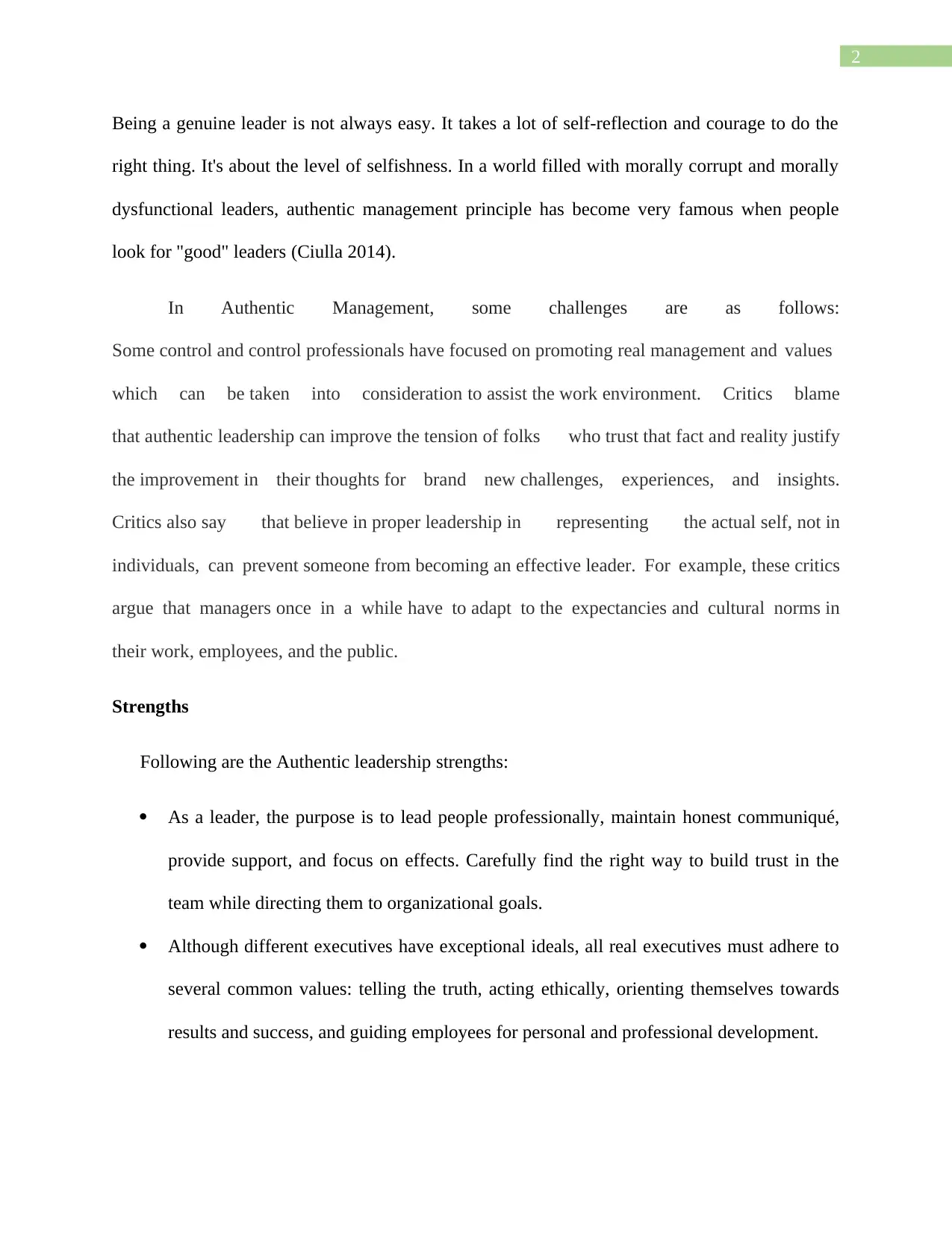
2
Being a genuine leader is not always easy. It takes a lot of self-reflection and courage to do the
right thing. It's about the level of selfishness. In a world filled with morally corrupt and morally
dysfunctional leaders, authentic management principle has become very famous when people
look for "good" leaders (Ciulla 2014).
In Authentic Management, some challenges are as follows:
Some control and control professionals have focused on promoting real management and values
which can be taken into consideration to assist the work environment. Critics blame
that authentic leadership can improve the tension of folks who trust that fact and reality justify
the improvement in their thoughts for brand new challenges, experiences, and insights.
Critics also say that believe in proper leadership in representing the actual self, not in
individuals, can prevent someone from becoming an effective leader. For example, these critics
argue that managers once in a while have to adapt to the expectancies and cultural norms in
their work, employees, and the public.
Strengths
Following are the Authentic leadership strengths:
As a leader, the purpose is to lead people professionally, maintain honest communiqué,
provide support, and focus on effects. Carefully find the right way to build trust in the
team while directing them to organizational goals.
Although different executives have exceptional ideals, all real executives must adhere to
several common values: telling the truth, acting ethically, orienting themselves towards
results and success, and guiding employees for personal and professional development.
Being a genuine leader is not always easy. It takes a lot of self-reflection and courage to do the
right thing. It's about the level of selfishness. In a world filled with morally corrupt and morally
dysfunctional leaders, authentic management principle has become very famous when people
look for "good" leaders (Ciulla 2014).
In Authentic Management, some challenges are as follows:
Some control and control professionals have focused on promoting real management and values
which can be taken into consideration to assist the work environment. Critics blame
that authentic leadership can improve the tension of folks who trust that fact and reality justify
the improvement in their thoughts for brand new challenges, experiences, and insights.
Critics also say that believe in proper leadership in representing the actual self, not in
individuals, can prevent someone from becoming an effective leader. For example, these critics
argue that managers once in a while have to adapt to the expectancies and cultural norms in
their work, employees, and the public.
Strengths
Following are the Authentic leadership strengths:
As a leader, the purpose is to lead people professionally, maintain honest communiqué,
provide support, and focus on effects. Carefully find the right way to build trust in the
team while directing them to organizational goals.
Although different executives have exceptional ideals, all real executives must adhere to
several common values: telling the truth, acting ethically, orienting themselves towards
results and success, and guiding employees for personal and professional development.
⊘ This is a preview!⊘
Do you want full access?
Subscribe today to unlock all pages.

Trusted by 1+ million students worldwide
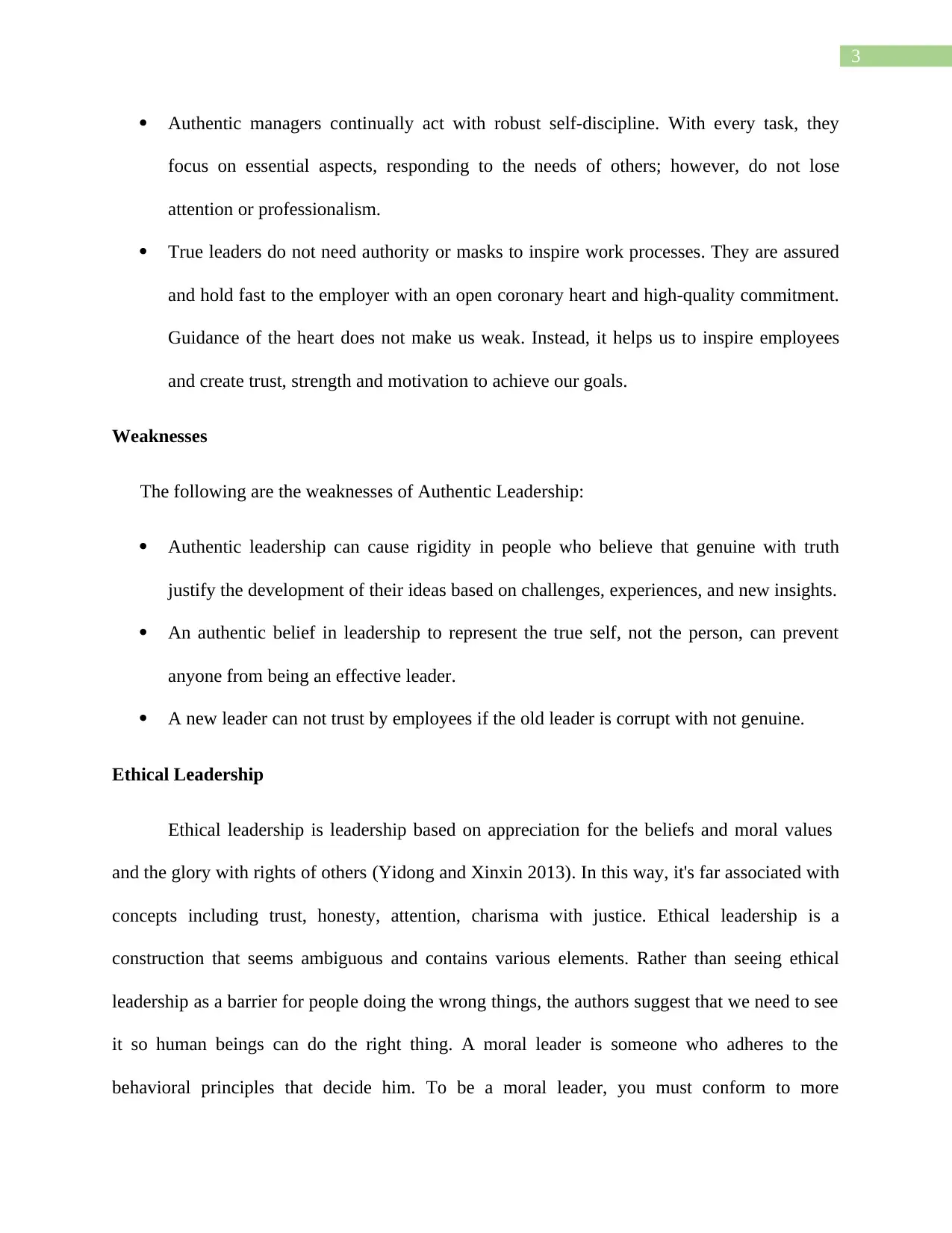
3
Authentic managers continually act with robust self-discipline. With every task, they
focus on essential aspects, responding to the needs of others; however, do not lose
attention or professionalism.
True leaders do not need authority or masks to inspire work processes. They are assured
and hold fast to the employer with an open coronary heart and high-quality commitment.
Guidance of the heart does not make us weak. Instead, it helps us to inspire employees
and create trust, strength and motivation to achieve our goals.
Weaknesses
The following are the weaknesses of Authentic Leadership:
Authentic leadership can cause rigidity in people who believe that genuine with truth
justify the development of their ideas based on challenges, experiences, and new insights.
An authentic belief in leadership to represent the true self, not the person, can prevent
anyone from being an effective leader.
A new leader can not trust by employees if the old leader is corrupt with not genuine.
Ethical Leadership
Ethical leadership is leadership based on appreciation for the beliefs and moral values
and the glory with rights of others (Yidong and Xinxin 2013). In this way, it's far associated with
concepts including trust, honesty, attention, charisma with justice. Ethical leadership is a
construction that seems ambiguous and contains various elements. Rather than seeing ethical
leadership as a barrier for people doing the wrong things, the authors suggest that we need to see
it so human beings can do the right thing. A moral leader is someone who adheres to the
behavioral principles that decide him. To be a moral leader, you must conform to more
Authentic managers continually act with robust self-discipline. With every task, they
focus on essential aspects, responding to the needs of others; however, do not lose
attention or professionalism.
True leaders do not need authority or masks to inspire work processes. They are assured
and hold fast to the employer with an open coronary heart and high-quality commitment.
Guidance of the heart does not make us weak. Instead, it helps us to inspire employees
and create trust, strength and motivation to achieve our goals.
Weaknesses
The following are the weaknesses of Authentic Leadership:
Authentic leadership can cause rigidity in people who believe that genuine with truth
justify the development of their ideas based on challenges, experiences, and new insights.
An authentic belief in leadership to represent the true self, not the person, can prevent
anyone from being an effective leader.
A new leader can not trust by employees if the old leader is corrupt with not genuine.
Ethical Leadership
Ethical leadership is leadership based on appreciation for the beliefs and moral values
and the glory with rights of others (Yidong and Xinxin 2013). In this way, it's far associated with
concepts including trust, honesty, attention, charisma with justice. Ethical leadership is a
construction that seems ambiguous and contains various elements. Rather than seeing ethical
leadership as a barrier for people doing the wrong things, the authors suggest that we need to see
it so human beings can do the right thing. A moral leader is someone who adheres to the
behavioral principles that decide him. To be a moral leader, you must conform to more
Paraphrase This Document
Need a fresh take? Get an instant paraphrase of this document with our AI Paraphraser

4
significant universal standards of moral conduct. Staying ethical is a manner of inquiry - asking
questions about what is proper and what is wrong - and conduct – for instance, for followers and
others about the right or wrong of sure movements.
Ethical leadership may be seen in terms of the most reliable power with the energy of
love, spotting that management is a reciprocal relationship with followers. A leader's challenge is
to serve and support, and his desire for leadership is based on compassion. Thus, Ethical
management is a style of leadership that emphasizes the ethical dimension of leadership in
management (Demirtas 2015). This relates to the values, moral characteristics and ethical
behavior of a leader in an organizational environment and its relationship with employees,
organizations and society. Ethical behavior is understood as something that can be judged
according to generally accepted standards of moral practice.
There are some challenges to Ethical Leadership are as follows: One of
the challenges of moral management is the potential to consistently obey the policies which
you have set for your company. Following your ethical requirements serves as an inspiration to
your employees and shows that you support your centre values. Ethics may be complicated. For
clarity, you have to write clear recommendations in the shape of task statements, regulations,
regulations, and practices. Since they may be hired, employees want printed copies of
the policies above. They must also be documented in a way that is
straightforward to apprehend and without a company gate. Work way of life and the
environment also can be a mission for moral leadership. In a depressed
environment, employees who may enjoy severe ethical issues may be afraid to speak out
of worry of being banned or maybe fired as "reporters". This means you have to hire center and
managerial staff carefully. References are continued and checked on the screen, looking
significant universal standards of moral conduct. Staying ethical is a manner of inquiry - asking
questions about what is proper and what is wrong - and conduct – for instance, for followers and
others about the right or wrong of sure movements.
Ethical leadership may be seen in terms of the most reliable power with the energy of
love, spotting that management is a reciprocal relationship with followers. A leader's challenge is
to serve and support, and his desire for leadership is based on compassion. Thus, Ethical
management is a style of leadership that emphasizes the ethical dimension of leadership in
management (Demirtas 2015). This relates to the values, moral characteristics and ethical
behavior of a leader in an organizational environment and its relationship with employees,
organizations and society. Ethical behavior is understood as something that can be judged
according to generally accepted standards of moral practice.
There are some challenges to Ethical Leadership are as follows: One of
the challenges of moral management is the potential to consistently obey the policies which
you have set for your company. Following your ethical requirements serves as an inspiration to
your employees and shows that you support your centre values. Ethics may be complicated. For
clarity, you have to write clear recommendations in the shape of task statements, regulations,
regulations, and practices. Since they may be hired, employees want printed copies of
the policies above. They must also be documented in a way that is
straightforward to apprehend and without a company gate. Work way of life and the
environment also can be a mission for moral leadership. In a depressed
environment, employees who may enjoy severe ethical issues may be afraid to speak out
of worry of being banned or maybe fired as "reporters". This means you have to hire center and
managerial staff carefully. References are continued and checked on the screen, looking

5
for specific features such as communication and worker skills. Managers who are right at what
they do may not be influential ethical leaders if they're introverted or anti-social. After recruiting
the proper people, emphasize an open-door policy because of this that employees can touch their
superiors overtly if they see a problem. Ethical leadership can be adamant when dealing
with morally grey areas. In such cases, the right thing may be of little advantage in
your company's profit.
Strengths
The following are the strengths of ethical leadership:
Ethical leaders are always careful. They are alert, attentive and conscientious with every
decision they make. These leaders take their positions seriously and demand that they and
their immediate employees succeed as often as possible.
Ethical leaders reduce business liability by preventing costly managerial reworks with
errors.
Ethical leaders have cast a positive impact on the individual, along with the organization
at large.
Ethical leadership focuses on relationships that are based on respect and trust, even if
there is not always agreement.
Ethical leadership creates a healthier environment with a more positive culture in the
workplace.
Ethical leaders are conscientious as they are careful with vigilant for their decision
making.
Weaknesses
for specific features such as communication and worker skills. Managers who are right at what
they do may not be influential ethical leaders if they're introverted or anti-social. After recruiting
the proper people, emphasize an open-door policy because of this that employees can touch their
superiors overtly if they see a problem. Ethical leadership can be adamant when dealing
with morally grey areas. In such cases, the right thing may be of little advantage in
your company's profit.
Strengths
The following are the strengths of ethical leadership:
Ethical leaders are always careful. They are alert, attentive and conscientious with every
decision they make. These leaders take their positions seriously and demand that they and
their immediate employees succeed as often as possible.
Ethical leaders reduce business liability by preventing costly managerial reworks with
errors.
Ethical leaders have cast a positive impact on the individual, along with the organization
at large.
Ethical leadership focuses on relationships that are based on respect and trust, even if
there is not always agreement.
Ethical leadership creates a healthier environment with a more positive culture in the
workplace.
Ethical leaders are conscientious as they are careful with vigilant for their decision
making.
Weaknesses
⊘ This is a preview!⊘
Do you want full access?
Subscribe today to unlock all pages.

Trusted by 1+ million students worldwide
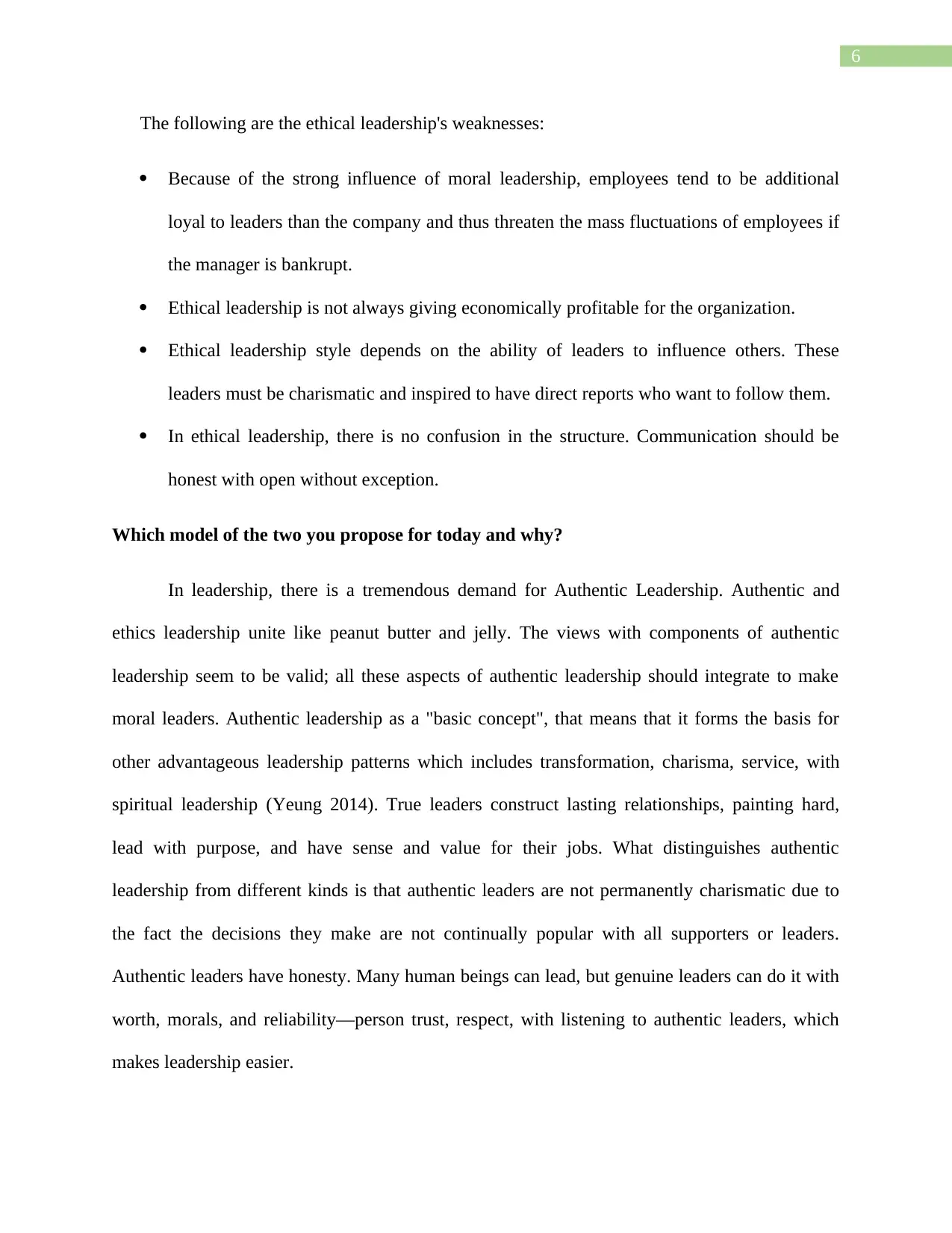
6
The following are the ethical leadership's weaknesses:
Because of the strong influence of moral leadership, employees tend to be additional
loyal to leaders than the company and thus threaten the mass fluctuations of employees if
the manager is bankrupt.
Ethical leadership is not always giving economically profitable for the organization.
Ethical leadership style depends on the ability of leaders to influence others. These
leaders must be charismatic and inspired to have direct reports who want to follow them.
In ethical leadership, there is no confusion in the structure. Communication should be
honest with open without exception.
Which model of the two you propose for today and why?
In leadership, there is a tremendous demand for Authentic Leadership. Authentic and
ethics leadership unite like peanut butter and jelly. The views with components of authentic
leadership seem to be valid; all these aspects of authentic leadership should integrate to make
moral leaders. Authentic leadership as a "basic concept", that means that it forms the basis for
other advantageous leadership patterns which includes transformation, charisma, service, with
spiritual leadership (Yeung 2014). True leaders construct lasting relationships, painting hard,
lead with purpose, and have sense and value for their jobs. What distinguishes authentic
leadership from different kinds is that authentic leaders are not permanently charismatic due to
the fact the decisions they make are not continually popular with all supporters or leaders.
Authentic leaders have honesty. Many human beings can lead, but genuine leaders can do it with
worth, morals, and reliability—person trust, respect, with listening to authentic leaders, which
makes leadership easier.
The following are the ethical leadership's weaknesses:
Because of the strong influence of moral leadership, employees tend to be additional
loyal to leaders than the company and thus threaten the mass fluctuations of employees if
the manager is bankrupt.
Ethical leadership is not always giving economically profitable for the organization.
Ethical leadership style depends on the ability of leaders to influence others. These
leaders must be charismatic and inspired to have direct reports who want to follow them.
In ethical leadership, there is no confusion in the structure. Communication should be
honest with open without exception.
Which model of the two you propose for today and why?
In leadership, there is a tremendous demand for Authentic Leadership. Authentic and
ethics leadership unite like peanut butter and jelly. The views with components of authentic
leadership seem to be valid; all these aspects of authentic leadership should integrate to make
moral leaders. Authentic leadership as a "basic concept", that means that it forms the basis for
other advantageous leadership patterns which includes transformation, charisma, service, with
spiritual leadership (Yeung 2014). True leaders construct lasting relationships, painting hard,
lead with purpose, and have sense and value for their jobs. What distinguishes authentic
leadership from different kinds is that authentic leaders are not permanently charismatic due to
the fact the decisions they make are not continually popular with all supporters or leaders.
Authentic leaders have honesty. Many human beings can lead, but genuine leaders can do it with
worth, morals, and reliability—person trust, respect, with listening to authentic leaders, which
makes leadership easier.
Paraphrase This Document
Need a fresh take? Get an instant paraphrase of this document with our AI Paraphraser

7
Authentic managers create working groups. They encourage friendship between and
among colleagues to connect people so that they have something different and other people who
work for each other rather than for themselves.
Authentic executives know themselves to promote the best performance in themselves
and the organization. Instead, authentic leaders strive to be the best and use mistakes and
mistakes to gain and advance wisdom. Thus, Authentic leadership significantly predicts
employee outcomes, including satisfaction, involvement, OCB, and results.
Authentic managers create working groups. They encourage friendship between and
among colleagues to connect people so that they have something different and other people who
work for each other rather than for themselves.
Authentic executives know themselves to promote the best performance in themselves
and the organization. Instead, authentic leaders strive to be the best and use mistakes and
mistakes to gain and advance wisdom. Thus, Authentic leadership significantly predicts
employee outcomes, including satisfaction, involvement, OCB, and results.
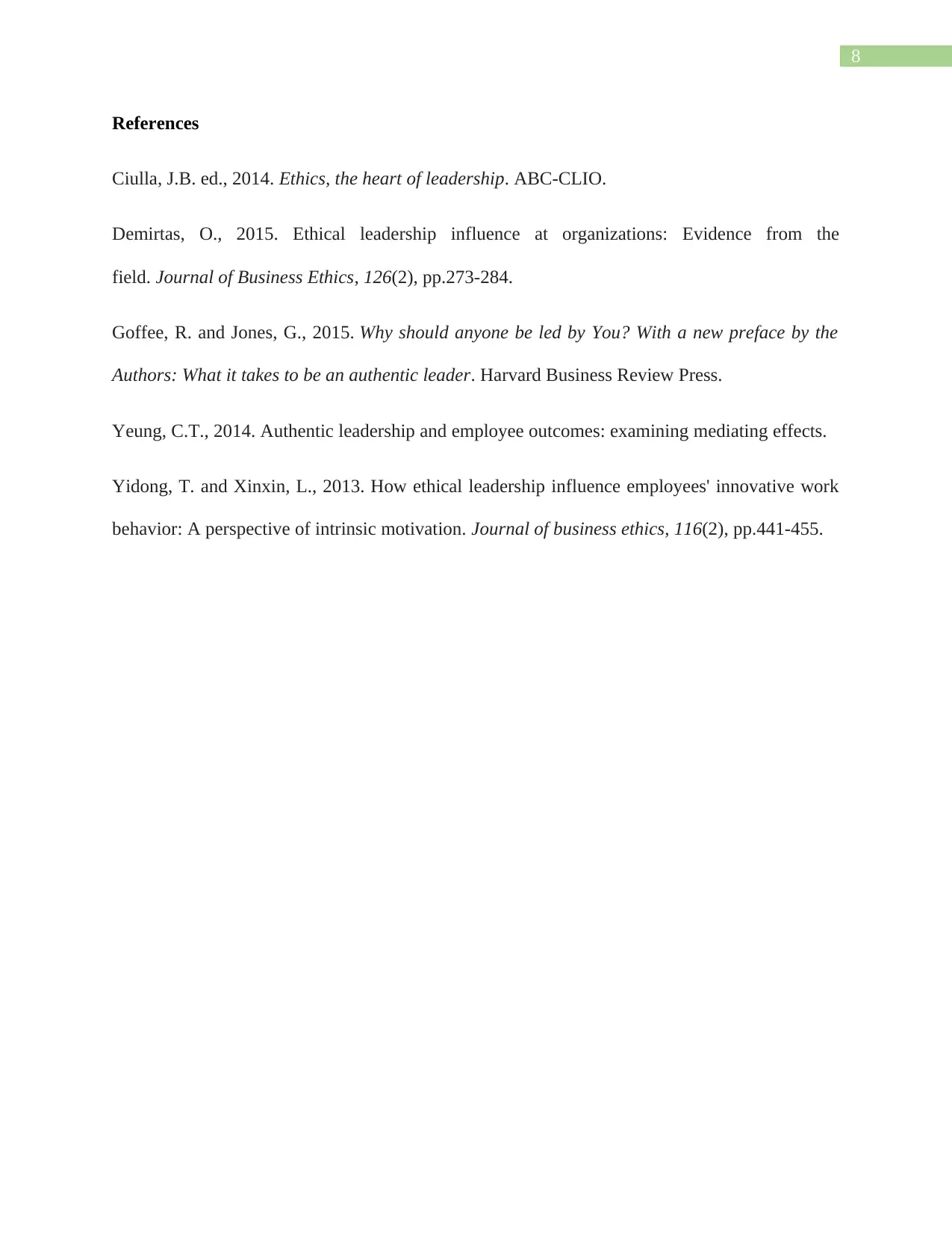
8
References
Ciulla, J.B. ed., 2014. Ethics, the heart of leadership. ABC-CLIO.
Demirtas, O., 2015. Ethical leadership influence at organizations: Evidence from the
field. Journal of Business Ethics, 126(2), pp.273-284.
Goffee, R. and Jones, G., 2015. Why should anyone be led by You? With a new preface by the
Authors: What it takes to be an authentic leader. Harvard Business Review Press.
Yeung, C.T., 2014. Authentic leadership and employee outcomes: examining mediating effects.
Yidong, T. and Xinxin, L., 2013. How ethical leadership influence employees' innovative work
behavior: A perspective of intrinsic motivation. Journal of business ethics, 116(2), pp.441-455.
References
Ciulla, J.B. ed., 2014. Ethics, the heart of leadership. ABC-CLIO.
Demirtas, O., 2015. Ethical leadership influence at organizations: Evidence from the
field. Journal of Business Ethics, 126(2), pp.273-284.
Goffee, R. and Jones, G., 2015. Why should anyone be led by You? With a new preface by the
Authors: What it takes to be an authentic leader. Harvard Business Review Press.
Yeung, C.T., 2014. Authentic leadership and employee outcomes: examining mediating effects.
Yidong, T. and Xinxin, L., 2013. How ethical leadership influence employees' innovative work
behavior: A perspective of intrinsic motivation. Journal of business ethics, 116(2), pp.441-455.
⊘ This is a preview!⊘
Do you want full access?
Subscribe today to unlock all pages.

Trusted by 1+ million students worldwide
1 out of 9
Related Documents
Your All-in-One AI-Powered Toolkit for Academic Success.
+13062052269
info@desklib.com
Available 24*7 on WhatsApp / Email
![[object Object]](/_next/static/media/star-bottom.7253800d.svg)
Unlock your academic potential
Copyright © 2020–2025 A2Z Services. All Rights Reserved. Developed and managed by ZUCOL.



